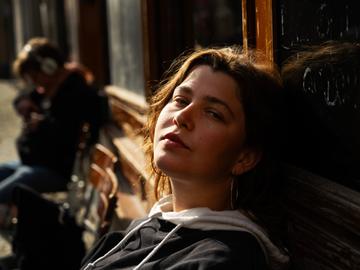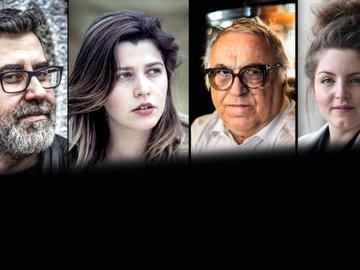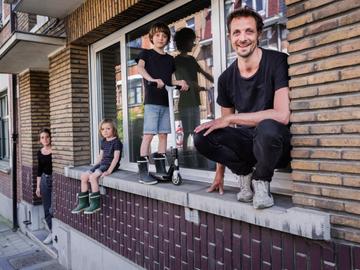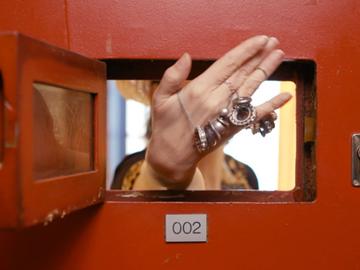Dance like the birds fly: impulsively and freely, in the urban public space, and all together – without hierarchy and without exclusion. That is the intention with Birds, the new project in which Seppe Baeyens, Yassin Mrabtifi and Martha Balthazar want to get an ultra-diverse cast, the public and chance passers-by moving.
© Saskia Vanderstichele
The old Delhaize site on Osseghemstraat/Rue Osseghem in Molenbeek has recently become the home of circus Espace Catastrophe, which has moved out of IJskelderstraat/Rue de la Glacière in Sint-Gillis/Saint-Gilles and changed its name to UP! − Circus & Performing Arts. This week you can also see Birds by Seppe Baeyens, Ultima Vez and KVS there.
As soon it is possible, Birds will become an interactive performance that will engage audiences and casual passers-by in public squares in cities, but the current Covid situation still requires a small in-between step. Hence the premiere in the large courtyard on Osseghemstraat/Rue Osseghem, which almost looks like a town square and which you can see from the street side, and from the old residential towers and new residential blocks.
We meet the three co-creators of this exceptional project. First there is Martha Balthazar, just graduated with a Master in Dramatic Arts from the KASK in Ghent, where she lived all her life before coming to Brussels at the very beginning of Birds for an internship with Seppe Baeyens. “I am not trained as a choreographer, but had seen Invited and was very impressed with the warmth and quality of Seppe's performance,” Balthazar says. “Once my Bachelor's was done, I had about had it with the boundaries of the classical theatre world. I found everything beyond that more interesting. Seppe's Atelier Quartier that I took part in here opened up a new world for me, in which the artistry was shared by everyone and there is an interesting overlap of what is too often called 'amateur art' in the professional field. That's what our industry needs.”
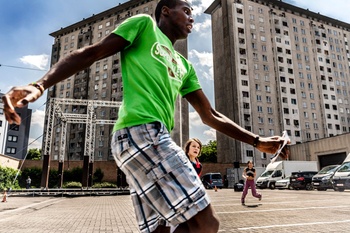
© Saskia Vanderstichele
| The ultra-diverse cast of ‘Birds’ will try to make you dance.
Martha Balthazar likes Brussels. “I dislike the annual wave of people from Ghent who, once they have moved to Brussels, talk about Ghent as the 'provincial town' with a kind of arrogance. But Brussels is many cities in one, and a cultural hotbed that goes beyond what takes place within theatres and exhibition spaces. In Brussels you are also confronted with the problems in a more immediate way. Where other cities manage better to push the misery to the outer edges, Brussels has failed to become an amusement park like so many other cities aspire to.”
NEW MIGRATION
That's where the good-humoured dancer and choreographer Yassin Mrabtifi comes in on a whim. He can't have come far, because he is still a passionate resident of Molenbeek, which he already portrayed in his dance stand-up comedy From Molenbeek with Love. “I can cycle to KVS, Ultima Vez and now Espace Catastrophe has settled here too. Following on Decoratelier and Recyclart, it's another sign that Molenbeek has changed a lot in a short time.”
“My street was once a mix of many cultures, then the Belgians moved away and the Moroccans stayed behind, now other people are moving in again, and many Flemish people too: that's the new migration in Brussels.”
We’re not going to take over or claim anything, but very gently infiltrate for a composition between cast, theatre audience and passers-by
Gentrification is lurking around the corner, Mrabtifi also sees how the global rise of the big cities plays into this. But the Beekkant district, where we are now, remains his district. “It is a little less well known than Zwarte Vijvers/Étangs Noirs but there's also a lot going on. The Abdeslam brothers were from here, and until the attacks there was nothing for young people to do here. After that the focus was on other parts of Molenbeek. I had few options myself, until I saw steppingstones here and there through artistic initiatives and community work. A business like MolenGeek also provides a lot of energy. The fact that some genius from Molenbeek (MolenGeek founder Ibrahim Ouassari, ed.) is known as far away as Silicon Valley shows that there are possibilities that can motivate young people and that go against the polarization and the far-right's vision of the hellhole.”
As for himself, Mrabtifi sees a role in showing the power of dance to the community. For example, this afternoon he's going to “do a sexy hip-hop cabaret dance at an assisted living facility,” something he's “looking forward to.”
97-YEAR-OLD DANCER
Finally, there is Seppe Baeyens, the initiator of Birds. He comes from Ultima Vez in Zwarte Vijversstraat/Rue des Étangs Noirs, where he started as a choreographer ten years ago. With Tornar and Invited he already made inclusive, intergenerational, participatory success productions. Baeyens has some good news; he will end his time with Ultima Vez after the last joint project Birds. This summer he will start under the auspices of his new non-profit organisation Leon, named after the 97-year-old dancer Leon Gyselynck, who among other things could be seen in Tornar.
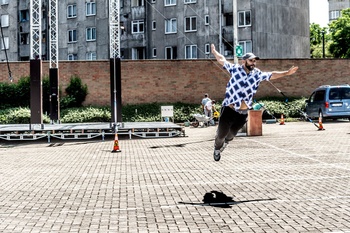
© Saskia Vanderstichele
| Yassin Mrabtifi: “Part of my mission is to show Molenbeek that it’s okay to dance. People look disapprovingly at a man who dances, but there in fact is a deep affection for dance in most communities.”
“We've made a show every three years until now − Tornar in 2015, Invited in 2018, and Birds in 2021. We want to do ten more shows three years apart. Why? Because I find the processes leading up to the performances more important and interesting than the productions themselves. I would like the productions to be the processes. Here in Molenbeek you can't plan something in advance, arrange it and then say 'come and see'. You have to base it on the environment you're in and have a bit of a run-up to get to know people. With Leon we are going to work on that. With a pool of artists, with dance as a binding agent in workshops and projects, and with a whole range of local organisations. After the summer, we will also take up a permanent position at the Huis van Culturen en Sociale Samenhang/Maison des Cultures et de la Cohésion Sociale.”
But first there is Birds, a performance with an eighteen-member cast that stems from Baeyens' Atelier Quartier, for the past three years organised on Saturdays – although not so much with a view to taking part in a performance, but with the aim of giving everyone a taste of dance as a common language.
Baeyens and Mrabtifi had been looking for an opportunity to do something together ever since they met in the kitchen and the backrooms of Ultima Vez, when Mrabtifi was playing in Talk to the Demon, Spiritual Unity or In Spite of Wishing and Wanting by Wim Vandekeybus. Balthazar has known Baeyens since she followed a workshop with him at Kopergietery as a child, and was an enthusiastic audience participant in Baeyens' celebrated participatory dance performance Invited, after which she initially joined the preliminary research for Birds as an intern.
Brussels is many cities in one, and a cultural hotbed that goes beyond what takes place within theatres and exhibition spaces
The predominantly non-professional cast is, even more than before with Baeyens, a mirror of Brussels society, in which all ages and backgrounds are represented. “Communities can learn a lot from each other, but they are too divided,” Baeyens says. “At school and in clubs, sixteen-year-olds are put together with all other sixteen-year-olds. We see the studio as a meeting place and want to democratise dance. Birds is more of a social composition than a technical dance composition.”
“It's the many encounters here that provide the energy we float on,” adds Balthazar, “that's how we come to a community where every individual is allowed to be there, but where there seem to be no leaders.”
Mrabtifi knows that dance not only can be democratic and accessible, but also risks encountering emotional or intellectual prejudices, but it is these prejudices that he wants to eliminate with great enthusiasm. “Part of my mission is to show Molenbeek that it's okay to dance. People look disapprovingly at a man who dances, but there in fact is a deep affection for dance in most communities. It is the way others look that often keeps people from dancing, and we want to break through that social pressure by dancing in the streets and inviting the others to dance with our eyes. Feeling good must prevail over the stress of the technical side or social pressure. When someone in our group lets go of his inhibitions and dares to open up, this in turn gives a tremendous energy to the others. Just as the cast members influence each other, they will also influence the audience and passers-by.”
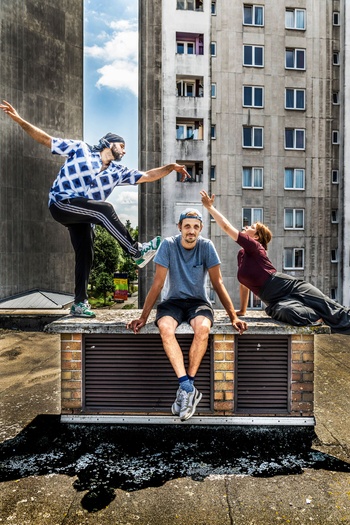
© Saskia Vanderstichele
| From left to right: Yassin Mrabtifi, Seppe Baeyens and Martha Balthazar, the co-creators of ‘Birds’.
Martha Balthazar: “In Invited and Birds, the other person looking is in fact what makes you dance because there's so much trust in it. You see the cohesion and connections in the cast and that works like a trampoline for the audience.”
“We have indeed noticed that eye contact is the basis,” agrees Baeyens. “With Invited we touched people physically, now with the masks we can't even offer a smile. But you can also create a softness and take someone into our temporary community with your body. When dancing, there is no right or wrong either. We create a safe playground where each individual can explore or complete dance in their own way. You can also feel free to choose not to participate and just watch. The cast is more of a catalyst than a performer, setting processes in motion for 60 to 70 minutes. Because the cast is very mixed, they also mix easily with audience members and passers-by. The meeting between the two musicians also creates a new language. Putting Saif Al-Qaissy, a traditional percussionist, and Stef Heeren, who works with electronics, together makes a personal link to many people.”
RULES AND CONVENTIONS
Between the former studios and the current première, there were experiments with local communities in the public space during residencies in Düsseldorf, Berlin, Ghent, Leuven and Molenbeek. Since Covid, the work has continued mostly in studios and semi-public spaces, such as at the Circularium business center, Decoratelier or La Maison des Cultures. It is a shame that the première will also take place in the semi-public courtyard in the Osseghemstraat/Rue Osseghem and not on a city square, but ten percent of the tickets will in any event go to local partners.
For me, the street is where the future of theatre lies because there is nowhere to hide there
Baeyens: “The public space is the starting point. In Invited, we invited the world into the theatre but still felt those theatre walls. Now we're bringing the theatre out into the world. We're not going to take over or claim anything, but very gently infiltrate for a composition between cast, theatre audience and passers-by. For example, by suddenly executing a walkway of a passer-by all together, or adding a circle to that pathway that eventually becomes a swirl.”
Balthazar: “Corona has made that exercise difficult, but also enormously relevant. So we're happy to have found a space like this that is still part of the city. There is now such a political tension on public space, on being together, on spontaneity and uncontrolled movements, that Birds is only going to get more interesting.”
Mrabtifi: “In plazas where people take their fast, straightforward route, we want to add something. To me, birds are the symbol of freedom that breaks through the straight lines. We want to draw the patterns of the birds in the sky on the ground so that the birds from above look down in surprise. For me, the street is also where the future of theatre lies because there is nowhere to hide there.”
Balthazar: “Even though the conventions in the space we call 'public' are extensive. Just standing still and looking around can seem threatening. Doing something together with more people quickly looks like a demonstration. The terraces also take up space from people who can't afford them. For example, roles in public space are also often gendered. Just playing sports in a square is still often a manly thing.”
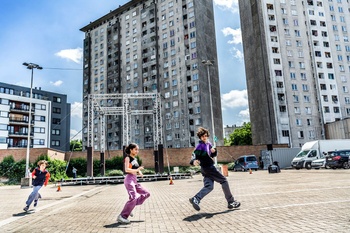
© Saskia Vanderstichele
After three years, the three co-creators are clearly ready for the première. “We don't easily exhaust all the things Birds touches on.” Baeyens still tells about that rehearsal afternoon when they just sat and watched how birds learned to swarm, flock and react to the impulses of the wind in astonishment. As a source of inspiration he also refers to the famous installation Der Lauf der Dinge by Peter Fischli and David Weiss, who used physical and chemical processes between everyday objects to compose a poetic, visual chain reaction.
Mrabtifi, for his part, talks about TikTok films in which local dancers regard the tourist terrace crowd as spectators, and Balthazar about how in Berlin, they started moving through the streets in a more fluid and playful way even outside of rehearsals, dreaming that all the city's inhabitants would adopt that attitude. This reminds Mrabitifi of the connecting ritual around the Kaäba in Mecca, also because of the circular movement that will be very present in Birds, bringing together the energy of those present and raising it to great spiritual heights. “Each performance will be different each time because the spaces, the participants, the perspectives and the events will bring something new each time.”
BIRDS
7 > 11/7, UP!, www.kvs.be, www.ultimavez.com
On 7 July, the soundtrack for Baeyens’ production Invited will be presented on CD. The Birds soundtrack will be released at the end of August.
Read more about: Podium , Seppe Baeyens , Yassin Mrabtifi , Martha Balthazar , Birds
